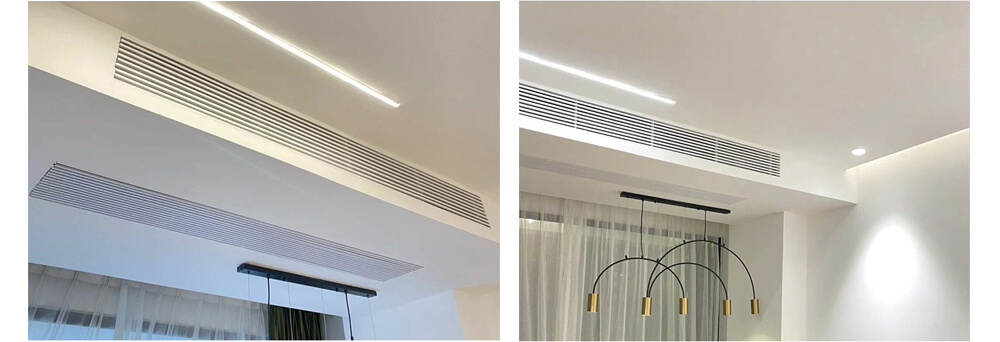The Heating, Ventilation, and Air Conditioning (HVAC) system is a complex network designed to ensure a comfortable indoor environment. It does so by regulating temperature, managing airflow, and filtering air. Central to its function are the HVAC components: grilles, registers, and duct fittings, each playing a unique role.
The Role of Grilles, Registers, and Duct Fittings in HVAC
- Grilles: These are the vent covers that you see on walls or ceilings. Their primary function is to cover air duct openings and direct airflow. Grilles are usually fixed and don’t have adjustable louvers.
- Registers: Similar to grilles, registers cover duct openings but come with adjustable louvers. This feature allows you to control the direction and flow of air entering a room.
- Duct Fittings: These are the connecting pieces within the ductwork. They include elbows, T-junctions, and reducers, crucial for managing air distribution and maintaining the efficiency of the HVAC system.
How These Components Impact Air Quality and Comfort
The placement and quality of grilles, registers, and duct fittings have a significant impact on indoor air quality and thermal comfort. They ensure efficient air distribution, prevent dust and debris from entering the system, and help maintain consistent temperatures throughout the space.
Interaction with Other HVAC Components
- Thermostats and Sensors: These components work in conjunction with thermostats and sensors. Properly installed grilles and registers ensure that airflow matches the thermostat settings, leading to efficient heating and cooling.
- Air Filters and Humidifiers: Duct fittings play a vital role in integrating air filters and humidifiers into the system. They help in filtering and humidifying the air before it circulates through the grilles and registers.
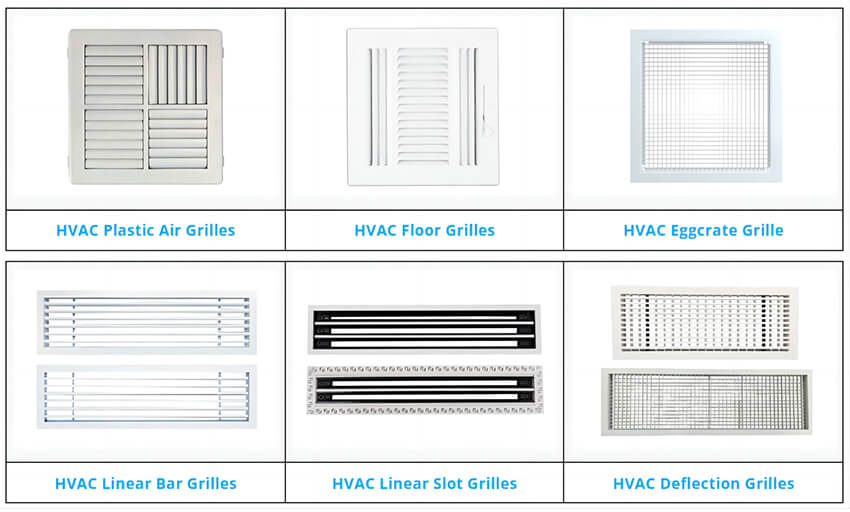
Types and Varieties
Understanding the various types of grilles, registers, and duct fittings is essential for selecting the right components for your HVAC system. Each type serves a specific purpose and comes with its own set of features.
Let’s take a look at a video for reference:
Exploring the Different Types of Grilles
- Linear Bar Grilles: Known for their sleek and modern appearance, linear bar grilles offer an aesthetic yet functional way to distribute air. They are ideal for contemporary spaces.
- Perforated Grilles: These grilles feature a series of small holes and are often used in residential and commercial settings for a more subtle appearance.
- Custom Decorative Grilles: For those who prioritize aesthetics, custom decorative grilles can be crafted to match interior design elements, blending functionality with style.
Varieties of Registers and Their Features
- Ceiling and Floor Registers: These registers are designed for specific placements – ceiling registers distribute air downwards, while floor registers direct air upwards. They are essential in managing room-by-room airflow.
- Wall Registers: Wall registers are used in rooms where ceiling or floor placements are not feasible. They help in evenly distributing air across the room.
- Adjustable Louvers: A key feature of registers is the presence of adjustable louvers, allowing control over air direction and flow. This customization is vital for optimizing comfort in different areas of a space.
Duct Fitting Types and Their Applications
- Elbows: Used to create turns or angles in the ductwork, elbows are crucial for navigating around obstacles within building structures.
- T-Junctions: T-junctions are used when the ductwork needs to branch off in different directions, ensuring efficient air distribution to multiple areas.
- Reducers: These fittings are essential for connecting ducts of different sizes, playing a key role in maintaining proper air pressure and flow within the system.
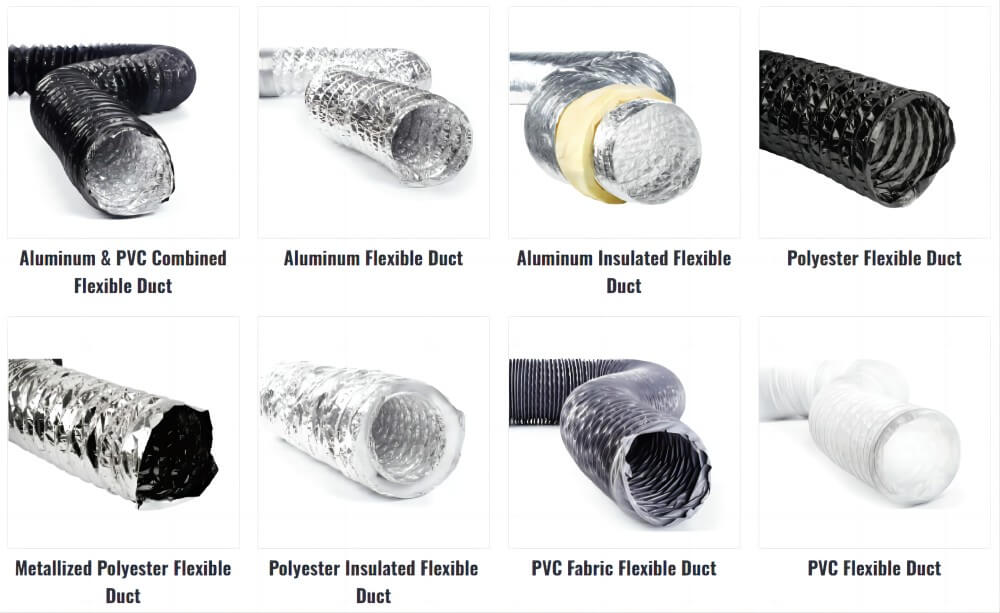
Material and Construction
The durability, efficiency, and overall performance of grilles, registers, and duct fittings largely depend on their material and construction quality. This section delves into the common materials used and the significance of construction quality in HVAC components.
Common Materials Used in HVAC Components
- Aluminum: Widely used due to its lightweight and corrosion-resistant properties, aluminum is a popular choice for grilles and registers. It’s ideal for environments prone to moisture.
- Plastic: Plastic components are cost-effective and versatile, often used in residential settings. However, they may not be as durable as metal options.
- Steel: Known for its strength and durability, steel is a common choice for commercial HVAC installations. It can withstand high temperatures and heavy usage.
- Wood: For a more traditional or decorative look, wood grilles and registers are available. They offer aesthetic appeal but require more maintenance and are less durable than metal options.
Construction Quality and Its Impact
- Precision Engineering: High-quality construction involves precise engineering and design to ensure optimal airflow and noise reduction.
- Durability: The lifespan of HVAC components is greatly influenced by their construction quality. Well-constructed components resist wear and tear and maintain their efficiency over time.
- Energy Efficiency: Properly built duct fittings and well-designed grilles and registers contribute to better energy efficiency of the HVAC system by minimizing air leakage and maintaining consistent airflow.
The Role of Construction in Aesthetics and Functionality
- Aesthetic Integration: High-quality construction allows for grilles and registers to be seamlessly integrated into a building’s interior design, enhancing aesthetic appeal.
- Functional Design: The construction quality also dictates how well the components perform their intended function, such as air distribution, noise reduction, and ease of maintenance.
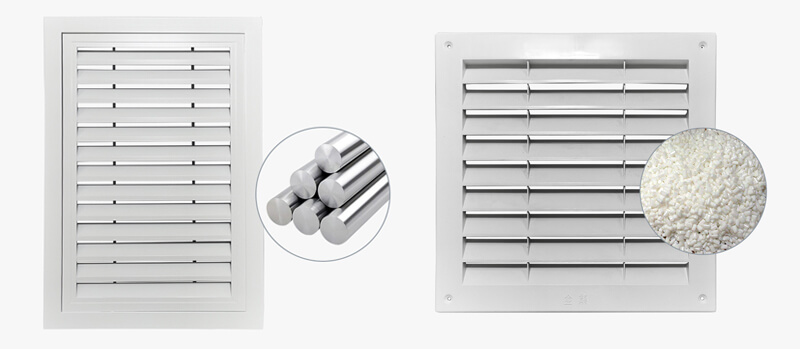
Design and Aesthetics
While the primary role of grilles, registers, and duct fittings is functional, their design and aesthetics are equally important. They not only contribute to the efficiency of an HVAC system but also play a significant role in the overall look and feel of a space.
Aesthetic Considerations in Choosing HVAC Components
- Complementing Interior Design: HVAC components should complement the interior design of a space. This involves selecting styles and finishes that blend with or enhance the room’s decor.
- Color and Finish Options: Many grilles and registers come in a variety of colors and finishes. Choices range from basic white or black to more elaborate bronze, brass, or even custom-painted options.
- Visible vs. Concealed Installation: Depending on the desired aesthetic, components can be visibly installed as a feature or concealed to blend into the surroundings.
Custom Designs: Tailoring to Individual Preferences
- Custom Sizing and Shapes: For unique spaces, custom-sized grilles and registers can be manufactured. This includes non-standard shapes and sizes, ensuring a perfect fit.
- Decorative Elements: Custom designs may include decorative elements like intricate patterns or themes to match specific interior design styles, from contemporary to classic.
The Impact of Design on HVAC Efficiency
- Design and Airflow: The design of grilles and registers directly impacts airflow. Aesthetically pleasing designs must also ensure efficient air distribution and circulation.
- Noise Reduction Features: Advanced designs incorporate noise reduction features, balancing aesthetic appeal with the practical aspect of creating a quiet and comfortable environment.

Installation and Compatibility
Proper installation and compatibility are crucial for the optimal functioning of grilles, registers, and duct fittings. This section focuses on guiding you through the installation process and helping you understand the compatibility aspects of these components with different HVAC systems.
Installation Basics of Grilles, Registers, and Duct Fittings
- Measuring and Sizing: Accurate measurement and sizing are critical. Ensure the components fit perfectly in the duct openings to prevent air leaks and inefficiency.
- Tools and Equipment: Basic tools like a screwdriver, drill, level, and tape measure are typically required for installation. Sometimes, more specialized tools may be needed.
- Step-by-Step Installation Guide: Provide a detailed guide on installing each component, from securing grilles to ensuring duct fittings are properly connected and sealed.
Compatibility with Different HVAC Systems
- Understanding System Requirements: Each HVAC system has its specific requirements for component compatibility, including size, type, and material.
- Impact on System Efficiency: Using incompatible components can lead to decreased efficiency, increased energy consumption, and even system damage.
- Consulting with Professionals: It’s often advisable to consult HVAC professionals to ensure compatibility, especially in complex systems or when upgrading components.
Advanced Installation Considerations
- Noise and Vibration Reduction: Installation techniques that help reduce noise and vibration, such as using insulation or vibration dampeners, are important for maintaining a comfortable environment.
- Airflow Optimization: Proper installation ensures optimal airflow, which is crucial for the efficiency and effectiveness of the HVAC system.
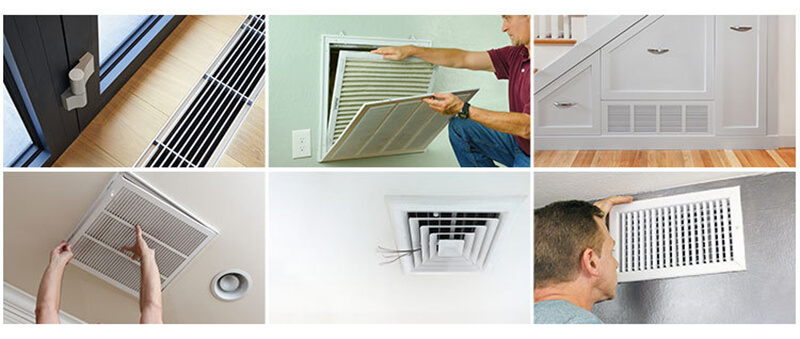
Performance and Efficiency
The performance and efficiency of an HVAC system are significantly influenced by the choice and proper use of grilles, registers, and duct fittings. Understanding how these components affect system efficiency is crucial for both energy conservation and ensuring a comfortable indoor environment.
The Role of Airflow Dynamics in HVAC Efficiency
- Optimizing Air Distribution: The design and placement of grilles and registers are pivotal in optimizing air distribution. Efficient airflow ensures uniform temperature control and reduces strain on the HVAC system.
- Impact of Duct Fittings on Airflow: Properly selected and installed duct fittings minimize air resistance and turbulence, contributing to smoother and more efficient air circulation.
Energy Efficiency: Reducing Consumption and Costs
- Energy Savings Through Proper Component Selection: Using the right grilles, registers, and duct fittings can lead to significant energy savings. This is achieved by maintaining proper air pressure and reducing the need for the system to work harder than necessary.
- Balancing Airflow and Energy Use: A balance between sufficient airflow and energy use is crucial. Overly restrictive components can increase energy consumption, while too open a design can reduce system effectiveness.
Advanced Efficiency Considerations
- Smart HVAC Components: The integration of smart technology in grilles and registers allows for automated airflow control, adapting to different needs and conditions, thereby enhancing energy efficiency.
- Long-Term Efficiency Benefits: Investing in high-quality, well-designed components can result in long-term efficiency benefits, including lower maintenance costs and extended system life.
Maintenance and Troubleshooting
Regular maintenance and effective troubleshooting are key to the longevity and efficiency of grilles, registers, and duct fittings in an HVAC system. This section provides insights into routine care and addressing common issues.
Regular Maintenance of Grilles, Registers, and Duct Fittings
- Cleaning and Dusting: Routine cleaning and dusting of grilles and registers prevent dust accumulation, ensuring efficient airflow and improved air quality.
- Inspection for Damage or Wear: Regularly inspect these components for any signs of damage or wear. This includes checking for rust, loose fittings, or any deformities.
- Seal and Insulate Ducts: Ensuring that duct fittings are properly sealed and insulated can prevent air leaks and improve system efficiency.
Troubleshooting Common Issues
- Reduced Airflow: If you notice reduced airflow, check for blockages or obstructions in grilles and registers. It might also indicate issues with duct fittings or other parts of the HVAC system.
- Unusual Noises: Rattling or buzzing sounds can be a sign of loose components. Tightening screws and ensuring proper fitting can often resolve this issue.
- Inconsistent Room Temperature: Inconsistent temperatures in different areas can indicate improper air distribution, requiring adjustment of registers or inspection of ductwork layout.
Preventative Maintenance Strategies
- Seasonal Check-ups: Engage in seasonal check-ups to ensure the system is ready for peak usage periods. This includes cleaning and adjusting components as necessary.
- Professional Inspections: Regular professional inspections can help identify and rectify issues before they become major problems, ensuring the system’s longevity and efficiency.

Advanced Topics
As the field of HVAC continues to evolve, understanding the latest advancements and how they apply to grilles, registers, and duct fittings is essential for staying ahead in efficient and effective climate control. This section dives into innovative trends and future possibilities in HVAC component technology.
Smart HVAC Components: Automation and Control
- Smart Grilles and Registers: These advanced components come equipped with sensors and automated controls that adjust airflow based on room occupancy, temperature, and air quality levels, enhancing both comfort and efficiency.
- Integration with Smart Home Systems: Smart HVAC components can be integrated into broader smart home systems, allowing for remote monitoring and control, and even predictive maintenance.
Innovations in HVAC Design and Materials
- Eco-Friendly Materials: The move towards sustainable and eco-friendly materials in manufacturing HVAC components not only supports environmental conservation but also introduces new levels of efficiency and durability.
- Aerodynamic Designs: Advances in aerodynamics are leading to the development of grilles and registers with optimized airflow patterns, reducing noise and energy usage.
The Future of HVAC Components
- IoT and AI Integration: The integration of the Internet of Things (IoT) and Artificial Intelligence (AI) in HVAC systems promises more adaptive and self-regulating environments, with components that can predict and adjust to changing conditions for optimal performance.
- Customization and Personalization: Future trends point towards more customizable and user-tailored HVAC solutions, where users can personalize settings for individual rooms and zones for maximum comfort and efficiency.
Choosing the Right Products
Selecting the right grilles, registers, and duct fittings is crucial for the efficiency, aesthetic appeal, and longevity of your HVAC system. This final section guides how to choose the best products for your specific needs.
Factors to Consider When Selecting HVAC Components
- Size and Fit: Ensuring the correct size and fit is fundamental. Incorrectly sized components can lead to poor air distribution and reduced efficiency.
- Material Quality: Choose materials that best suit your environment and usage requirements. Consider factors like durability, maintenance, and aesthetic preferences.
- Design and Aesthetic: The design should complement your interior decor while also providing the functional benefits of efficient airflow and noise reduction.
Understanding Manufacturer Reputation and Product Reviews
- Researching Brands: Look into the reputation of manufacturers. Established brands with positive reviews are often indicative of quality and reliability.
- Reading Customer Reviews: Customer reviews can provide practical insights into the performance and durability of the products in real-world scenarios.
Recommended Brands and Products (Without Endorsements)
- List of Reputable Brands: Provide a list of well-known and reputable brands known for their quality in the HVAC sector.
- Product Recommendations: Offer a selection of products known for their reliability, efficiency, and value for money. Note that this is not an endorsement but a guide based on market research and customer feedback.

Conclusion
As we conclude our comprehensive guide on understanding grilles, registers, and duct fittings, it’s important to reflect on the key insights gained and the impact they have on the efficiency and effectiveness of HVAC systems.
The Importance of Informed Choices in HVAC Components
- Enhancing System Performance: The selection and maintenance of the right HVAC components are crucial in enhancing system performance and ensuring a comfortable indoor environment.
- Energy Efficiency and Cost Savings: By understanding and implementing the concepts discussed, you can achieve significant energy efficiency and cost savings.
Encouraging Proactive Engagement with HVAC Systems
- Empowerment Through Knowledge: Armed with the knowledge from this guide, you are now better equipped to make informed decisions about your HVAC system, whether it’s for installation, maintenance, or upgrades.
- The Value of Regular Maintenance: Remember the importance of regular maintenance and the role it plays in the longevity and efficiency of your system.
Looking Forward to Future Innovations
- Adapting to New Technologies: Stay open to emerging technologies and innovations in the HVAC field, as they continue to offer new ways to improve system efficiency and comfort.
- Continuous Learning and Adaptation: The world of HVAC is ever-evolving, and keeping abreast of new developments will ensure that your system remains state-of-the-art and efficient.
FAQs: Understanding Grilles, Registers, and Duct Fittings
Selecting the Right Components
Q: How do I choose the right size grille or register for my space?
- A: Measure the duct opening accurately and select a grille or register that matches these dimensions. It’s crucial for efficient airflow and system performance.
Q: What factors should I consider when choosing materials for these components?
- A: Consider the environment (moisture, temperature), the level of usage, and aesthetic preferences. Durability and maintenance requirements are key factors.
Installation and Maintenance
Q: Can I install grilles and registers myself, or do I need a professional?
- A: Basic installations can often be done DIY with the right tools. However, for complex systems or if you’re unsure, it’s safer to consult a professional.
Q: How often should I clean my HVAC components?
- A: Regular cleaning, at least once every few months, is recommended. This prevents dust build-up and maintains air quality and system efficiency.
Troubleshooting and Efficiency
Q: What should I do if I notice reduced airflow or strange noises from my vents?
- A: Check for blockages, ensure all components are tightly secured, and inspect for any damage. If the problem persists, consult a professional.
Q: How do these components affect my HVAC system’s energy efficiency?
- A: Properly sized and installed components ensure optimal airflow, reducing the strain on your HVAC system and leading to energy savings.
Advanced Considerations
Q: Are there smart grilles and registers available? What are their benefits?
- A: Yes, smart grilles and registers can automatically adjust airflow based on room conditions. They offer enhanced comfort, and efficiency, and can be integrated into smart home systems.
Q: How can I ensure that my HVAC components are future-proof?
- A: Opt for high-quality, adaptable components, and stay informed about new technologies and innovations in the HVAC field.
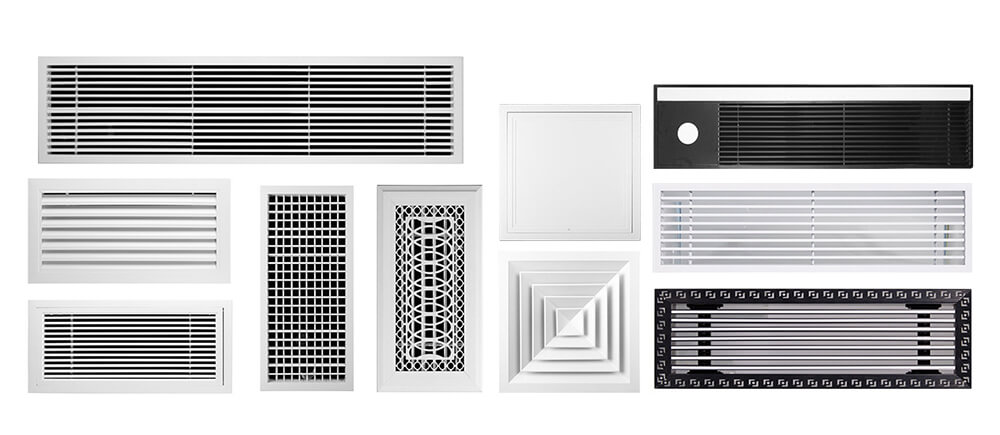
If you want to know more, please click below:
- Grilles, Registers & Diffusers – The Ultimate Guide
- HVAC Linear Slot Diffusers – The Ultimate Guide
- HVAC Egg Crate Diffuser – The Ultimate Guide
- HVAC Jet Nozzle Diffuser – The Ultimate Guide
- HVAC Linear Bar Grilles – The Ultimate Guide
- HVAC Air Swirl Diffusers – The Ultimate Guide
- HVAC Round Ceiling Diffusers – The Ultimate Guide
- Round Ceiling Diffusers – The Ultimate Guide
- Exhaust Air Louver – The Ultimate Guide
- HVAC Registers – The Ultimate Guide

